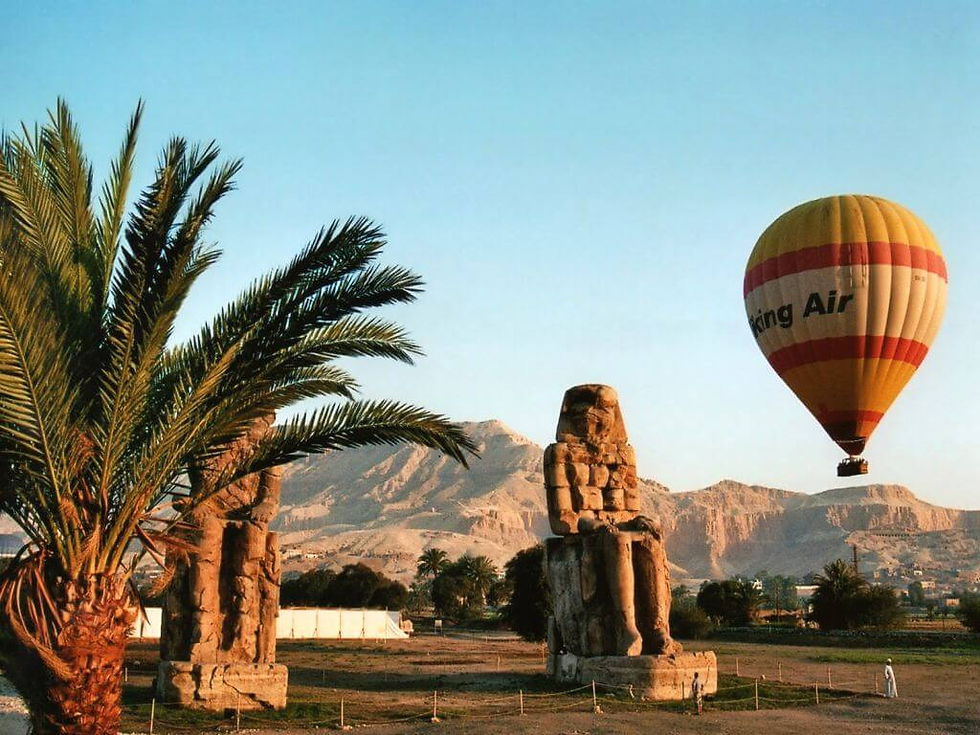7 Things to do in Luxor this year
- mahamim2517
- Jan 30, 2020
- 4 min read
Established on the shore of the great Nile river and surrounded by both mango plantations and desert, Luxor is a city of half a million inhabitants, containing some of the largest and most striking ancient monuments ever constructed.
The history of Luxor (originally called the city of Thebes) dates back to 3,200 B.C. Nevertheless, the city didn’t prosper until the 2,134 B.C., during the 11th Dynasty, when Mentuhotep II brought peace and stability to the region, and Thebes started to grow as a city, becoming, during the 18th Dynasty, in 1,550 B.C., the religious and political capital of Ancient Egypt.
Luxor is the most important archaeological site in Egypt, where you can enjoy the world's greatest open-air museum.
Temple of Karnak

Of all Luxor's many monuments, the Temple Complex of Karnak has to be its most astonishing and beautiful feat. Within its precincts are the Great Temple of Amun, the Temple of Khons, and the Festival Temple of Tuthmosis III, as well as many other buildings. It is not built to a single unified plan but represents the building activity of many successive rulers of Egypt, who vied with one another in adding to and adorning this great national sanctuary, which became the most important of Egypt's temples during the New Kingdom.
All the monuments here are on a gigantic scale, reducing visitors to ant-like proportions as they gaze up at mighty columns and colossal statuary. Even if you're short on time, don't scrimp on your visit here. You need at least three hours to try and make sense of the entire complex.
Luxor temple

The enormous Luxor Temple was one of the great constructions of the New Kingdom (dating from the 14th century BC) dedicated to the god Amun. It was known as the “Southern Sanctuary” and was the site of ceremonies aimed at encouraging the life-giving Nile floods. Once through the processional Avenue of Sphinxes you come to the First Pylon, which announces the phenomenal scale of the stonework here: statues, columns and obelisks all compete with each other in a race to the sky. Ensuing civilizations have also left their marks: there’s a shrine erected by Alexander the Great, Roman wall frescoes as well as the 14th century AD mosque, ensuring this remains a place of worship in the present day.
Dendera temples

Dendera is one of the least visited major temples in Egypt, which is kind of ironic, as it happens to be one of the best-preserved temple complexes at the same time. The colorful hypostyle hall really has no rival and is worth a trip in itself.
Dendera also happens to be one of the very few temples with an intact roof. You can follow a winding passage with an outstanding mural of a religious procession to the chambers on the top. Here you’ll also find the famous Dendera zodiac – one of the earliest renditions of Taurus and Libra and “the only complete map that we have of an ancient sky”.
Valley of the Kings

World-famous and rightly so. This is, in essence, the most impressive cemetery in the world. A valley full of 60 odd decadent, intricate tombs for a host of kings from the Egyptian dynasties. Your ticket allows you to enter 3 tombs (Ramses 3, 4 and 9 are the most impressive). Disappointingly, all the hieroglyphics within the tombs are behind thick Perspex glass but with a drop of imagination, you can imagine the hundreds of people drafted in to work on these things all those centuries ago and your sense of awe will be restored. Again, I’m no Egyptian historian so 3 tombs was easily enough and at the risk of sounding uncouth once you’ve seen three it feels like you’ve seen them all.
On the other hand, Tutankhamun’s tomb is very understated, small and generally underwhelming so the additional is entirely up to you. I choose to pay it as I had come all that way, it was still worth it.
Tomb of Seti I (KV 17)

One of the great achievements of Egyptian art, this cathedral-like tomb is the finest in the Valley of the Kings. Long closed to visitors, it is now reopened and if you can afford the ticket, it is money well spent. The 137m-long tomb was completely decorated and beautifully preserved when Giovanni Belzoni opened it in 1817, and although it has suffered since, it still offers an eye-popping experience – art from Seti's reign is among the finest in Egypt.
Felucca Ride to Banana Island

If you've had your fill of temples and tombs for the day, there is no better way to relax in Luxor than to take a felucca ride to Banana Island. Five kilometers upriver from Luxor, this teeny palm-shaded island is the perfect chilled-out contrast to the history-filled treasures of the West and East Bank. Hop on a felucca in the late afternoon after a long day of temple and tomb viewing, and sit back to watch the Nile-side views as the boat captain raises the sail and you slide up the river. If you sail back just on sunset, you'll get to see the river at its most majestic.
Hot-air balloon ride

With a dramatic price ranges between 300-1000 EGP, you may think it dictates the quality of service, the transport, the food, the health and safety – you’d be wrong. What it depends on is how wealthy you appear, your bartering skills and the twinkle in your eye. I paid 350 EGP, you shouldn’t pay more than 450 really and don’t book it from the internet, sort it out when you get to Luxor; there are no shortage of vendors.
You get around 45 minutes in the air as the sun rises over the Nile. An activity you won’t forget for a long time. Sure it’s touristy, but who cares when it’s bloody awesome!







Comments